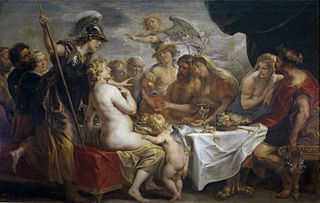 W
WArchitectural painting is a form of genre painting where the predominant focus lies on architecture, including both outdoor and interior views. While architecture was present in many of the earliest paintings and illuminations, it was mainly used as background or to provide rhythm to a painting. In the Renaissance, architecture was used to emphasize the perspective and create a sense of depth, like in Masaccio's Holy Trinity from the 1420s.
 W
WDutch Golden Age painting is the painting of the Dutch Golden Age, a period in Dutch history roughly spanning the 17th century, during and after the later part of the Eighty Years' War (1568–1648) for Dutch independence.
 W
WEarly Netherlandish painting, traditionally known as the Flemish Primitives, refers to the work of artists active in the Burgundian and Habsburg Netherlands during the 15th- and 16th-century Northern Renaissance period. It flourished especially in the cities of Bruges, Ghent, Mechelen, Leuven, Tournai and Brussels, all in present-day Belgium. The period begins approximately with Robert Campin and Jan van Eyck in the 1420s and lasts at least until the death of Gerard David in 1523, although many scholars extend it to the start of the Dutch Revolt in 1566 or 1568. Early Netherlandish painting coincides with the Early and High Italian Renaissance but the early period is seen as an independent artistic evolution, separate from the Renaissance humanism that characterised developments in Italy, although beginning in the 1490s as increasing numbers of Netherlandish and other Northern painters traveled to Italy, Renaissance ideals and painting styles were incorporated into northern painting. As a result, Early Netherlandish painters are often categorised as belonging to both the Northern Renaissance and the Late or International Gothic.
 W
WThe Feast of the Gods or Banquet of the Gods as a subject in art showing a group of deities at table has a long history going back into antiquity. Showing Greco-Roman deities, it enjoyed a revival in popularity in the Italian Renaissance, and then in the Low Countries during the 16th century, when it was popular with Northern Mannerist painters, at least partly as an opportunity to show copious amounts of nudity.
 W
WMerry company is the term in art history for a painting, usually from the 17th century, showing a small group of people enjoying themselves, usually seated with drinks, and often music-making. These scenes are a very common type of genre painting of the Dutch Golden Age and Flemish Baroque; it is estimated that nearly two thirds of Dutch genre scenes show people drinking.
 W
WPronkstilleven is a style of ornate still life painting, which was developed in the 1640s in Antwerp from where it spread quickly to the Dutch Republic.
 W
WDe Stijl, Dutch for "The Style", also known as Neoplasticism, was a Dutch art movement founded in 1917 in Leiden. De Stijl consisted of artists and architects. In a narrower sense, the term De Stijl is used to refer to a body of work from 1917 to 1931 founded in the Netherlands. Proponents of De Stijl advocated pure abstraction and universality by a reduction to the essentials of form and colour; they simplified visual compositions to vertical and horizontal, using only black, white and primary colors.
 W
WWillink van Collenprijs is a former Dutch art award, which was awarded for the first time in 1880 by the Sociëteit Arti et Amicitiae. It was intended as an encouragement award for young artists, and was considered as a national counterpart to the Paris Salon. Its existence of more than 71 years proves the success of Amsterdam's art policy. For many of its winners, it was a valuable boost to their careers in the Dutch art world. Some of the prize winners were also recognized abroad and remain well known today.